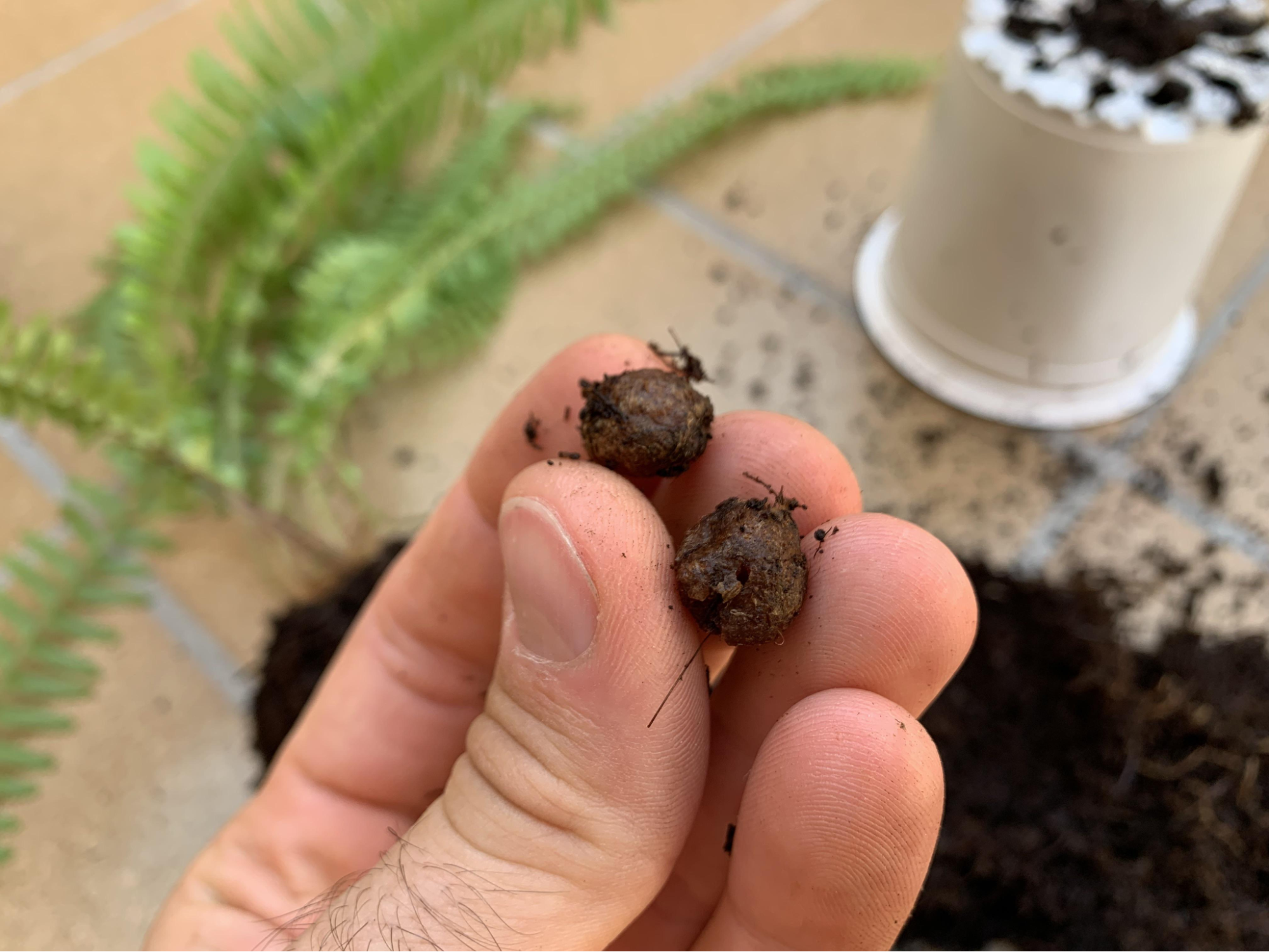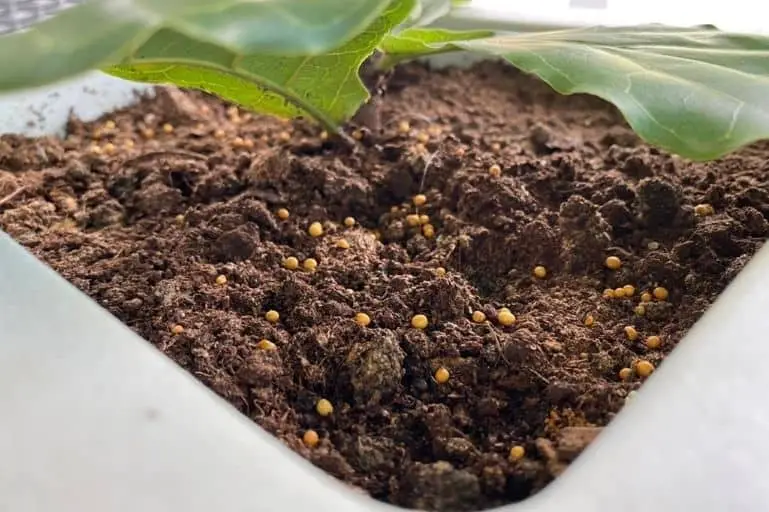You’re probably concerned about small issues if you’re a garden freak. So, naturally, you raise your eyebrows when you see brown balls in the soil of your garden.
So, what are these brown balls in soil?
Mostly the brown balls you notice in the soil are fungi. These fungi can come in many colors and brown is one of them. Soil compaction and contamination are mainly responsible for forming this fungus. Then, overwatering the soil, and lack of sunlight initiate these brown balls in your soil. If it’s not a fungus, then these brown balls are fertilizer pellets, pests eggs, and LECA.
We will discuss every possible cause and solution for forming these brown fungi in this plant care article. Moreover, you’ll receive a caretaking guide for avoiding this problem.
Brown Balls in Soil: Major Possible Cause
The brown balls you’re seeing in your outdoor plant are fungus. These fungi can take many forms and colors. Some species produce brown balls in the soil called sclerotia, which are small, round structures.
Often, sclerotia help fungi survive harsh environmental conditions. Fungal growth can also occur when favorable conditions are present. These brown balls disperse the millions of spores which result in the powder which will likely lead to increasing spore growth in the soil.

Do Brown Balls Cause Problems for Plants?
These brown fungi cause problems for plants. Plants can be suffocated by them when they grow inside them. Given favorable growing conditions, these organisms can emerge in both outdoor garden soil and indoor potted plants.
Usually, the impact of this condition is mainly observed on the flowers and tender branches of plants. It results in the formation of a bulge that could potentially cause the death of the stem.
The fungus in question thrives on fruits and can cause damage to them. Moreover, it can affect the roots, stems, or leaves of plants which leads to symptoms like wilting, yellowing, stunting, or even death of the plant.
Brown Balls – What Are The Reasons And Remedies?
If you want to get rid of these brown balls, you need to know the exact reasons for these happenings. Also, you must know the remedies so that you can avoid these kinds of situations.
Before going tothe detailed discussion let’s have a glimpse of the reasons and remedies.
| Reasons | Remedies |
| Soil compaction | Ensure proper drainage system |
| Soil contamination | Clean the soil |
| Overwatering | Don’t water too much |
| Lack of sunlight | Ensure proper sunlight |
| Absence of proper ventilation | Make sure proper ventilation |
Reason 1: Soil Compaction
Soil compaction is the first possible reason for emerging brown balls in the soil. When soil is too compacted, it can prevent adequate water infiltration and air exchange. This can create conditions that favor the growth of certain fungi and bacteria.
These microorganisms then produce small, round structures that include brown balls as part of their life cycle. Also, the compaction of soil can cause brown balls to form as a result of soil aggregates.
Therefore, soil compaction is unlikely to directly cause brown balls, but it may promote the growth of microorganisms that produce them or lead to soil aggregates that resemble brown balls.
Moreover, if your pot has no drainage holes, or if the pot is too large for the plant’s growth, water will accumulate in the pot, resulting in brown fungus growth.
Remedy:
Compaction of soil can be prevented by avoiding heavy machinery or foot traffic. Then, use a minimum amount of tillage to reduce soil compaction and maintain a healthy soil structure.
Also, never work on wet soil, because the soil is more susceptible to compaction when it is wet. Usually, the brown fungus thrives in warm and humid conditions, which is why it’s important to expose your soil to adequate sunlight.
So, watering once a week should be sufficient. Providing ample sunlight can help prevent fungus growth by moistening regularly.

Reason 2: Soil Contamination
The next leading reason for forming brown balls in the soil is contaminated soil. Soil is home to a diverse range of microorganisms and insects. Brown balls can grow in soils with inadequate soil management due to increased pest and microbe populations.
Also, wilted leaves, blossoms, and fruits affected by this fungus can provide a substrate for its spores to germinate and grow.
Remedy:
The affected plants should be removed and not used as compost. Then, fallen leaves, flowers, and fruits should be collected and disposed of in a trash can, since these can provide nutrients for the fungus.
To prevent the further spread of the fungus, it’s important to wipe off the plant leaves daily.
Reason 3: Overwatering
One of the significant reasons for forming brown balls in the soil is overwatering. When soil is excessively moist, it can provide optimal conditions for the spores of the fungus to germinate and grow rapidly.
Consequently, this can facilitate the proliferation of brown fungus in the soil. Excessive watering is also culpable for your precious saga leaves curling.
Remedy:
You need to stay away from overwatering your soil. Keep your plants healthy by watering them only when the first inch of soil becomes dry. By inserting your finger into the soil, you can check the moisture level.
Reason 4: Lack of Sunlight
A lack of sunlight also causes soil to become dumped and as a result, high levels of moisture in the soil promote fungus growth. In the absence of sunlight, the soil can help evaporate excess moisture.
Inadequate sunlight can also result in calla lily flowers turning green. Also, sunlight sterilizes the soil and reduces the growth of fungi and other microorganisms.
Remedy:
To fix this issue, you need to ensure that your soil is getting enough sunlight. If your soil is not getting enough light, consider moving them to a location where it can receive more direct sunlight. Find a spot that gets at least six hours of sunlight per day.
Also, if you think that your garden is getting darker day by day due to plants being shaded, you have to prune your trees. This will allow more light to reach your soil.
Reason 5: Absence of Proper Ventilation
Air circulation is necessary for the perfect health of the soil. If the soil is suffering from insufficient air circulation, you may notice that some brown balls are forming in the soil.
The compacted soil cannot allow air to circulate properly, resulting in anaerobic pockets. The oxygen-deprived soil pockets can promote the growth of bacteria and fungi that cause brown balls to form.
Remedy:
You have to ensure proper ventilation in the soil to prevent this issue. You can do it by loosening compacted soil. The soil structure can be improved by adding organic matter and using pots with proper drainage holes.
Also, make sure to allow your soil to get dried out properly between watering. It can help prevent excess moisture and nutrient accumulation that can lead to the formation of brown balls.
Brown Balls in Soil: Other Possible Causes
Though fungus is the most obvious reason for brown balls in soil, there are some other possibilities as well. Let’s shed light on them now.
Fertilizer Pellet:
Pellets are another possibility after fungus. Occasionally, slow-release fertilizers are packaged as small, brown balls. So, the brown balls could be caused by fertilizer you recently added to your soil.
Pest Eggs:
Then, small brown balls can be insect eggs or pest eggs in the soil in some cases. A gardening expert may be able to offer advice on how to proceed if you suspect this may be the case.

LECA:
Another kind of brown ball you can see in the soil is the LECA ball. LECA stands for Lightweight expanded clay aggregate. LECA consists of clay balls that expand when submerged in water and can be utilized for watering plants. This is artificial and used in indoor plants.
How to Take Care of the Soil to Get Rid of Brown Balls
Care is Better than prevention. So you should take care of your soil if you don’t want to see any kind of brown balls. Here are some general tips that may help.
- Poor soil health or nutrient deficiencies can cause brown balls in the soil. Consider adding organic matter to your soil, such as compost or leaf mold, or using a slow-release fertilizer.
- You can identify any nutrient deficiencies or pH imbalances contributing to brown balls by conducting a soil test. If you are unsure about the composition of your soil, you can test it yourself or have it tested by a professional. So that you can take proper measures according to the status of your soil.
- Always keep your soil clean. You should remove all the debris like leaves, dead plants, dogs, and bird poop from the soil surface and dispose of it properly.
- Make sure you’re watering your plants only when they need it, and that you’re not leaving them sitting in standing water.
- Also, raised beds can improve drainage and aeration, as can amending the soil with sand or perlite.
Frequently Asked Questions (FAQs):
What Are The Colored Balls In My Plant Soil?
Colored balls that are yellow or orange found in soil, are likely slow-release fertilizers, specifically Osmocote, a product that releases nutrients slowly. The color of these fertilizers typically fades and they become hollow after 4 to 5 months at ambient temperatures. Then, yellow balls in the soil may be insect eggs if they are slimy and soft.
Can You Mix Clay Pebbles With Soil?
Of course, you can use clay pebbles with soil as an additive. It helps to improve drainage which ensures that your plant’s roots have access to the right amount of water. Moreover, You can use clay pebbles as a complete growing medium, or as a base layer.
What Do Slug Eggs Look Like?
A slug egg looks like a small, round, jelly-like ball that tends to clump together in a slimy substance. They can appear in a variety of colors, including brown, grey, white, yellow, pearl, or even slightly transparent. Typically, these eggs are found in damp, dimly-lit areas like under leaf litter, on low-growing leaves, or in the soil.
Conclusion
Hopefully, you have found your answer regarding brown balls in soil. You don’t need to freak out when you notice them in your soil. All you need to take proper care and prevention which you’ve got in the article.
If anything slips away from your hands, you must go for garden experts’ advice. Best wishes for your venture. Happy gardening!
- Why Are There Still No Tomatoes in My Tomato Plants? Let’s Fix the Issue! - July 13, 2023
- Water Propagation White Stuff on Roots: Everything You Should Know! - July 11, 2023
- String of Dolphins Drying Up: Solved! - July 11, 2023
